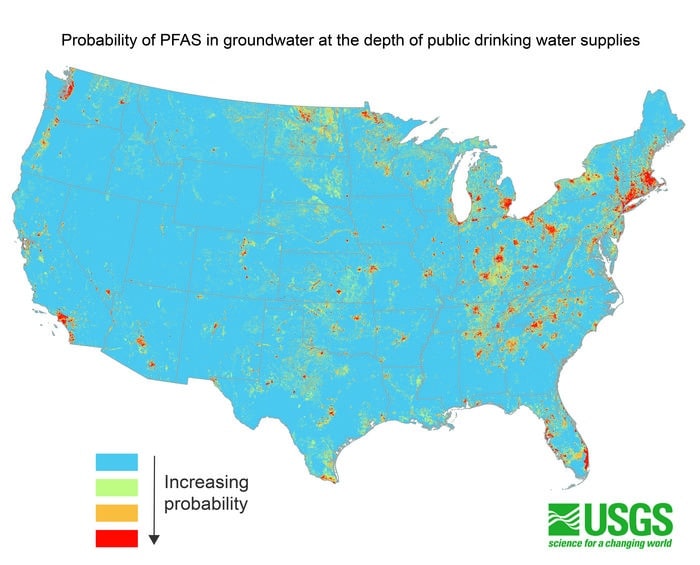A new USGS study reveals that millions of Americans may be drinking groundwater contaminated with PFAS. This research highlights the prevalence of these “forever chemicals” and their potential health risks.
Up to 95 million people in the contiguous United States may be consuming groundwater contaminated with per- and polyfluoroalkyl substances (PFAS), according to a recent study published by the U.S. Geological Survey (USGS). This staggering figure represents more than 20% of the country’s population.
The study, published in the journal Science, is the first to offer national estimates of PFAS prevalence in untreated groundwater supplying both public and private wells. Utilizing a predictive model, the research promises to equip the public, water suppliers and regulators with vital data to better manage and safeguard drinking water resources.
PFAS are synthetic chemicals found in everyday products like non-stick cookware, food packaging and firefighting foams. Often referred to as “forever chemicals,” they persist in the environment and accumulate over time, posing significant concerns for drinking water quality. Exposure to certain PFAS can lead to adverse health effects, the U.S. Environmental Protection Agency (EPA) warns.
“This study’s findings indicate widespread PFAS contamination in groundwater that is used for public and private drinking water supplies in the U.S.,” lead author Andrea Tokranov, a USGS research hydrologist, said in a news release. “This new predictive model can help prioritize areas for future sampling to help ensure people aren’t unknowingly drinking contaminated water. This is especially important for private well users, who may not have information on water quality in their region and may not have the same access to testing and treatment that public water suppliers do.”
The USGS has developed an interactive online map detailing the likelihood of PFAS occurrence by region, allowing users to visualize the probability of contamination.
These estimates, however, are not meant for assessing individual household risks and do not reflect actions taken by states, municipalities or households to mitigate contamination. Testing remains the only definitive method to confirm PFAS presence.
The scale of this potential contamination underscores the urgency for public awareness and action. States like Florida and California have the largest populations using public water supplies potentially affected, while Michigan, Florida, North Carolina, Pennsylvania, New York and Ohio report high figures for private wells.
In some areas, the percentage of populations relying on potentially contaminated groundwater is particularly alarming. For example, in Massachusetts, 86% to 98% of people relying on public groundwater may be affected. In Connecticut, 67% to 87% of private well users face similar risks.

Credit: U.S. Geological Survey
“To derive these estimates, the team analyzed 1,238 groundwater samples collected by USGS scientists and determined how factors such as urban development and well depth can impact PFAS occurrence,” Tokranov added. “With that information, a detailed machine learning model was developed and used to identify which geographic areas have a higher likelihood for contamination. That information was combined with existing USGS research on the number of people in a given area who rely on groundwater for drinking water to establish population estimates.”
Federal and state agencies are making efforts to regulate and mitigate PFAS contamination. The EPA has set maximum contaminant levels for six PFAS types in public water systems, with some states imposing additional regulations. For households using private wells, the responsibility for water testing and treatment falls on the residents.
The severity of PFAS contamination and its long-term impact on public health underscores the importance of this research. As the USGS continues to investigate and monitor these chemicals, the findings will play a crucial role in informing policy and protective measures.

